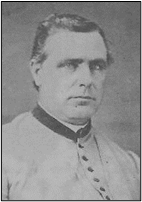A cholera epidemic ravaged northwest Ohio in 1849, and among the victims was a widow in Minster, Ohio, who as she lay dying of the disease, entrusted her 12-year-old son to Fr. Andrew Kunkler, C.PP.S. The boy was raised by the Missionaries of the Precious Blood, was professed in the Congregation in 1854, and ordained to the priesthood in 1859 at the age of 22.
That boy was Joseph Dwenger, who would have an important role in the history of the American Province and of the Diocese of Fort Wayne, Ind., where he would become its second bishop.
In his treatment of Dwenger, the late Fr. Dominic Gerlach, C.PP.S., notes that there he had a significant impact on the history of the Congregation in the United States. He arranged for the purchase of the property where St. Charles Seminary would eventually be located and was its founding rector. He also established Saint Joseph’s College in Rensselaer, Ind. The following draws heavily on Gerlach’s work.
The village of Carthagena (established in 1842) had originally been a settlement of Blacks. They had gained their freedom before the Civil War and had settled in Cincinnati. A race riot in 1829 led them to seek a more remote settlement, and so they carved out little 40-acre farms in the wilderness of Mercer County beginning in 1835. A white Quaker philanthropist founded the Emlen Institute (near where the seminary building now stands) as a kind of industrial training school for Blacks. By 1860, there were over one hundred Black families in the vicinity.
Dwenger was instrumental in purchasing the Emlen Institute property after the school had closed. The purchase of the property had to be done by a ruse: Dwenger did not reveal that he was a priest because of the fear of anti-Catholic prejudice. The Emlen Institute had by this time been relocated to the Philadelphia area.
In time, the Black population declined, so that by 1945 only a single Black family remained. Today, there is still physical evidence of the Black colony: the Black cemetery (Protestant) adjacent to the St. Aloysius Parish cemetery at Carthagena. Three of the stained-glass windows in St. Aloysius Church portray Black saints or saints who ministered with Black populations.
C.PP.S. seminary education in the early 19th century had been rather primitive, as it was nearly everywhere in the country. C.PP.S. seminary training was apparently particularly lacking. In the several “convents” that served in succession as “seminaries,” it was sometimes a matter of students teaching each other, and after two years of formal training, the newly ordained priest was admonished to continue his studies on his own.
When Bishop Rappe of Cleveland expressed his dissatisfaction with the C.PP.S. training, Brunner moved his “seminary” to Mercer County, eventually locating it in the Himmelgarten convent. But in the late 1850s, Rome prevailed upon him to send two of his students, Joseph Dwenger and Paul Reutter, to Mount St. Mary’s Seminary near Cincinnati. Immediately after his ordination, Dwenger was appointed C.PP.S. seminary rector, and it was he who arranged the purchase of the Emlen Institute property, as noted above, and he enlarged it into the first St. Charles Seminary.
The Souvenir Centenary Booklet of St. Charles, 1961, tells the story of the major seminary. There had been three seminary buildings: 1861 (Old Abbey), 1876 (Old Sem), and 1922 (the present grand building). Incidentally, St. Charles was the first C.PP.S. house in America in which the CPPS Sisters were not a part. This was done at the behest of the moderator general and was to be the first step towards separating the two groups. This house then became the “mother house” of the province, even though it was often not the home of the provincial headquarters. The sisters did come to take over the kitchen and laundry in the late 1870s.
Dwenger was the first American-born vocation, claimed by both Minster and Maria Stein. He surely would have become provincial director except that in 1872 he was selected to become the second bishop of Fort Wayne, a diocese then comprising the northern third of Indiana. As bishop, he gained national prominence for his work in establishing and administering parochial schools in a diocesan system. He achieved some status at the Third Council of Baltimore despite the double handicap of being a religious and non-Irish. In fact, he was chosen to present the decrees of the Council to Pope Leo XIII.
It was he who was principally responsible for the establishment of Saint Joseph’s College. He had at first approached the Benedictines to establish a kind of a second St. Meinrad’s, but he finally got the C.PP.S. to do so in 1888. During his episcopacy, St. Katherine Drexel established a school for Native American boys in Rensselaer. When the school closed, the property, which was adjacent to Saint Joseph’s, was acquired by the college. A building on the SJC campus is named for Bishop Dwenger.
Dwenger also supported the Poor Handmaids of Jesus Christ and their work in his diocese. He established an orphan asylum for boys in Lafayette, Ind., and a similar institution for girls in Fort Wayne. He also was supportive of the Pontifical North American College in Rome.
Dwenger died at age 56 but had made significant contributions to the life of the Congregation and the Church in northern Indiana. Today a Catholic high school in Fort Wayne is named for this orphan boy who became a zealous priest and bishop.

